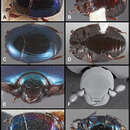Phelister riehli: Brief Summary
(
Minangkabau
)
fornecido por wikipedia MIN
Phelister riehli adolah kumbang dari famili Histeridae. Spesies ko juo marupokan bagian dari ordo Coleoptera, kelas Insecta, filum Arthropoda, dan kingdom Animalia.
Kumbang iko punyo elitra nan pendek dan antena.
Description
(
Inglês
)
fornecido por Zookeys
Length: 2.2–2.3mm, width: 1.7–2.0mm; body elongate oval, almost parallel-sided, moderately depressed, glabrous; most of body, including venter, metallic blue to greenish-blue, elytra moderately to strongly violet; frons elevated over antennal bases, depressed at middle, ground punctation rather conspicuous, with small secondary punctures on epistoma, slightly larger punctures in frontal depression, frontal stria present along inner margin of eye, fragmented to absent across front, supraorbital stria vaguely represented by series of punctures; antennal scape short, club slightly asymmetrically oblong; epistoma slightly convex along apical margin, truncate; labrum about 3×wider than long, weakly emarginate to bisinuate along apical margin; both mandibles with acute basal tooth; pronotal sides weakly convergent in basal half, arcuate to apex, marginal stria complete along lateral and anterior margins, lateral submarginal stria absent, ground punctation of pronotal disk rather conspicuous, interspersed with small secondary punctures nearly throughout, only lacking in posteromedial region; elytra with two complete epipleural striae, outer subhumeral stria absent, inner subhumeral stria present as basal and frequently median fragments, dorsal striae 1–3 complete, 4th stria variably abbreviated from base, 5th and sutural striae absent, elytral disk with few coarse punctures in apical fourth; prosternum narrowed between procoxae, weakly convex, keel truncate to very weakly emarginate at base, carinal striae complete, divergent anterad and posterad, separate throughout; prosternal lobe about two-thirds keel length, apical margin subtruncate, marginal stria obsolete; mesoventrite weakly emarginate, slightly sinuate at middle, with a complete stria slightly removed from margin which is probably the mesometaventral stria, strongly displaced anterad; lateral metaventral stria originating freely near mesocoxa, curving posterolaterad toward middle of metacoxa, slightly abbreviated apically, outer lateral metaventral stria absent, metaventral disk impunctate at middle; abdominal ventrite 1 with single, complete lateral stria, middle portion of disk with few small punctures along apical margin; protibia 4–5 dentate, the basal one or two denticles weak, outer margin serrulate between teeth; meso- and metatibiae rather elongate, narrow, mesotibia with two weak marginal spines; outer metatibial margin smooth; propygidium with complete transverse basal stria, discal punctures rather small, ocellate, separated more or less uniformly by about their diameters; propygidial gland openings conspicuous behind ends of transverse basal stria, about one-fourth from each lateral margin; pygidium with sparse ground punctation interspersed with small secondary punctures throughout, these slightly larger and denser toward base. Male genitalia (Fig. 13): T8 slightly longer than broad, sides subparallel to weakly rounded, basal emargination broad, shallow, apical emargination very shallow, ventrolateral apodemes separated by about one-half maximum T8 width, extending about one-third distad beneath, strongly narrowed in apical half; S8 about as long as T8, divided, inner margins approximate along basal one-fourth, strongly divergent apically, outer margins subparallel, convergent to apex, apical guides well developed in apical apical two-thirds, elongate, narrowly rounded apically, lacking apical setae; T9 with basal apodemes thin, almost two-thirds total length, T9 apices narrowly subacute, glabrous, weakly opposing, ventrolateral apodemes weakly projecting beneath; S9 stem thin near basal one-third, weakly bulbous at base, head wide, curved to horn-like apicolateral points, desclerotized along midline, with narrow apicomedial division; tegmen with sides subparallel in basal half, weakly widened to near apex, slightly bulbous apically, dorsobasal edge weakly arcuate, tegmen in lateral aspect more or less straight; median lobe about one-third tegmen length; basal piece about one-fourth tegmen length.
- licença
- cc-by-3.0
- direitos autorais
- Michael S. Caterino, Alexey K. Tishechkin
- citação bibliográfica
- Caterino M, Tishechkin A (2013) A systematic revision of Baconia Lewis (Coleoptera, Histeridae, Exosternini) ZooKeys 343: 1–297
- autor
- Michael S. Caterino
- autor
- Alexey K. Tishechkin

